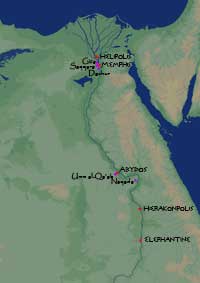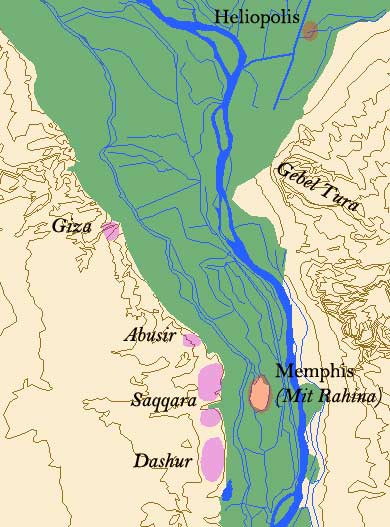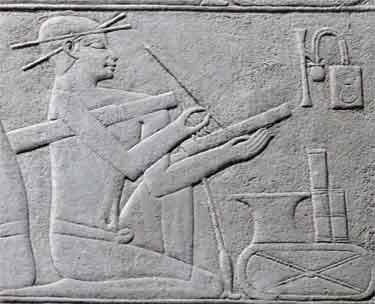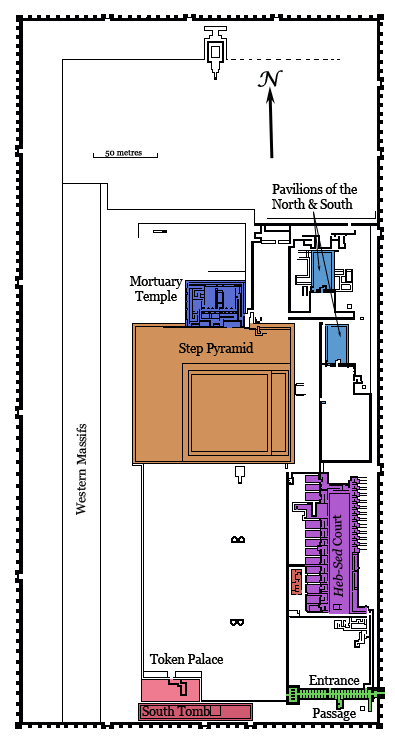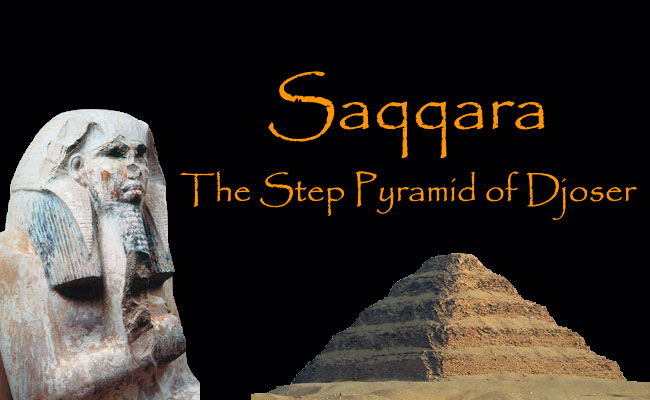
Djoser and Imhotep
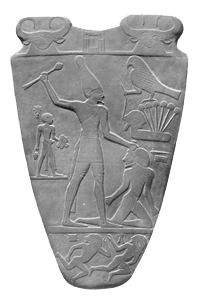 When the pharaoh Djoser took the throne nearly five thousand years ago, he inherited a kingdom that had only recently emerged from a prolonged period of civil war. Traditionally the country had been divided into Lower Egypt (the Delta) and Upper Egypt (the Nile Valley). They were two highly distinctive regions, with different economies, lifestyles, belief systems and artistic traditions. After a long struggle, they had finally been forged into a single kingdom by Menes (as Manetho, the Ptolemaic historian calls him), an event that took place about 250 years before
When the pharaoh Djoser took the throne nearly five thousand years ago, he inherited a kingdom that had only recently emerged from a prolonged period of civil war. Traditionally the country had been divided into Lower Egypt (the Delta) and Upper Egypt (the Nile Valley). They were two highly distinctive regions, with different economies, lifestyles, belief systems and artistic traditions. After a long struggle, they had finally been forged into a single kingdom by Menes (as Manetho, the Ptolemaic historian calls him), an event that took place about 250 years before 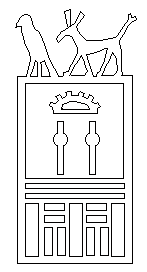 Djoser’s day. It is not known which early pharaoh was the historical figure but a good candidate is Narmer, shown (left) wearing the crown of Upper Egypt and smiting the head of a northerner.
Djoser’s day. It is not known which early pharaoh was the historical figure but a good candidate is Narmer, shown (left) wearing the crown of Upper Egypt and smiting the head of a northerner.
However, the union was a fragile one and the forces of separatism remained strong in the north. The years before Djoser were apparently characterized by rival pharaohs and civil war— the royal cemeteries show signs of massive destruction and burning. There appears to have been a religious element to the conflict as well, with rival factions supporting the gods Horus (Upper Egypt) and Seth (Lower Egypt. Eventually the Land was reunited by the pharaoh Khasekhemwy (“Appearance of the Two Powers”) who included both gods on the serekh that surrounds his royal name (right). Khasekhemwy apparently died without male issue and, with his death, the Second Dynasty came to an end. 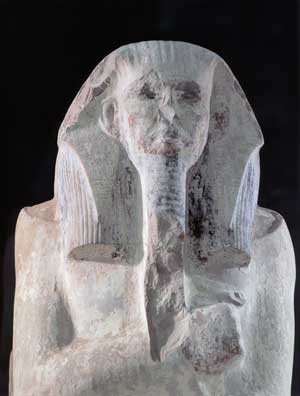
Djoser probably became pharaoh through marriage to the royal heiress. Later Egyptian tradition (Manetho and the Turin Canon) place a pharaoh named Sanakht before Djoser but, according to contemporary sealings found at Abydos, it was the latter who supervised the old king’s burial, a role traditionally assumed by the dead pharaoh’s successor. Nothing much is known of Sanakht although he is said to have reigned 20 years. He and Djoser were probably brothers and the scribes of a thousand years later simply got them mixed up. Actually, the name Djoser is only known from later records but it may have been his birth-name. In his inscriptions he uses his Horus name, Netjerikhet (“Divine of the Body”).
A new dynasty meant a new beginning for the country, which was at peace but still far from united. In order to ensure stability, Djoser needed to focus attention onto the divine kingship as a symbol of centralized authority and the best way to do that was through the construction of a monumental tomb. Of course, previous kings had left pretty impressive monuments behind but these were made out mud-brick and were only completed after the pharaoh’s death. Having seen for himself the ruined state of most of these as a result of civil war or natural decay, Djoser aimed at something more permanent to symbolize the permanence of the new order. His tomb would be made out of stone, even including the elements normally made out of wood such as doors and window frames. The project would involve all of the material resources of the kingdom and the labour of thousands, drawn from every part of the land.
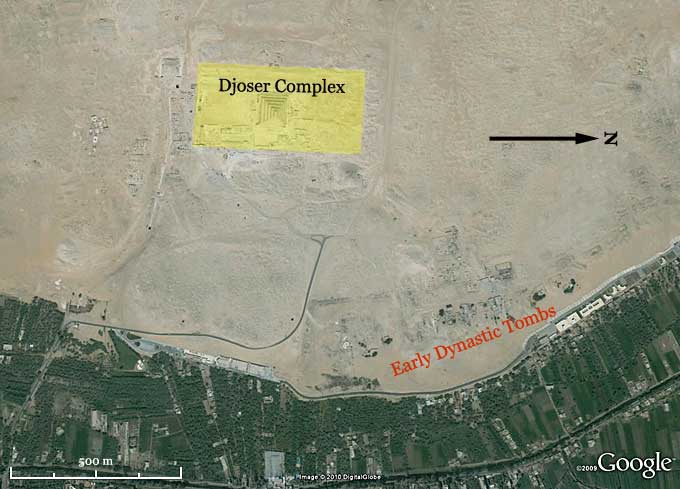
GoogleEarth© View of Saqqara
The site chosen for the tomb was Saqqara, which lay to the west of the Egyptian capital city of Memphis. The location was symbolic. Memphis was located at the junction of the Delta and the Nile Valley, of Upper and Lower Egypt. Saqqara had been used as cemetery ever since the foundation of the city. Silhouetted along a ridge running along the edge of the desert and highly visible from the city was a line of mastabas associated with the kings of Dynasties I. However, by Djoser’s day they all lay in ruins, destroyed during the excesses of the recent civil wars. He planned to build his funerary monument (it was more than just a tomb) on the highest part of the site and and designed it to combine elements from earlier tombs and funerary palaces. The plan grew in size and complexity as the project went on, and eventually covered an area of over 15 hectares (544 x 277 metres).
Imhotep 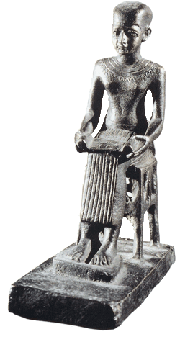
The project envisioned by Djoser was unprecedented and presented huge logistical problems. Fortunately, the right man for the job was at hand, his vizier Imhotep. According to his own inscriptions, he was,
Chancellor of the king of Lower Egypt, pre-eminent after the king of Upper Egypt, hereditary prince, controller of the palace, great seer [High Priest of Heliopolis], Imhotep, builder and sculptor.
His reputation among later Egyptians, especially the Ptolemies, was such that he was worshipped as a god, the son of Ptah and there were shrines to him throughout the country. Manetho wrote that during Djoser’s day,
... there lived Imouthes who from his skill in medicine was regarded as Asclepios among Egyptians. He discovered the building technique of carved stones and also applied himself to writing.
To develop a tradition of stone masonry virtually overnight, as Imhotep apparently did, was an amazing acheivement. It required precision cutting and dressing of the stone so that they were all of standard sizes. Unlike shovelling mud into wooden forms, these were skills that took time to learn. There were stone carvers about, making items such as stelae, stone bowls and cosmetic palettes, but they were relatively few in number and hundreds more would have to be trained in order to finish the job.
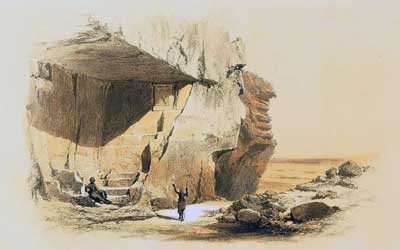 Quarrying and transporting the stone would involve the labour of even more people. Most of the stone was found at the site but the fine limestones used for the outer casing had to be brought from the quarries at Tura (left) on the opposite side of the river. All of these people had to be housed and fed, involving troops of bakers, butchers, and brewers.
Quarrying and transporting the stone would involve the labour of even more people. Most of the stone was found at the site but the fine limestones used for the outer casing had to be brought from the quarries at Tura (left) on the opposite side of the river. All of these people had to be housed and fed, involving troops of bakers, butchers, and brewers.
Coordinating these activities was a small army of scribes and managers at all levels. While writing had existed in Egypt for several centuries by this point, it had mainly been a matter of inventories and religious dedications. This project involved the transmission of precise instructions from one part of the country to another. Henceforward, there would be a highly skilled bureaucracy available to the central government that could be applied to any project.
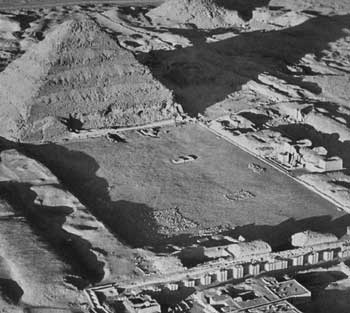 Imhotep was almost certainly buried somewhere close to his master, as was the custom in those days, but his tomb has yet been discovered.
Imhotep was almost certainly buried somewhere close to his master, as was the custom in those days, but his tomb has yet been discovered.
The Djoser Complex
When it was complete, the complex covered just over 15 hectares and contained a number of different elements. Obviously, the step pyramid was the dominant element, towering some 60 metres above the plain. At the time of its completion, it was the tallest structure in Egypt, perhaps even in the world, and would have dominated the western skyline when view from the capital city of Memphis. In addition, there were large courtyards to the north and south of the pyramid, a number of temples, shrines and other buildings, and a southern tomb. The whole thing was enclosed by massive limestone walls over 10 metres high and studded with towers.

